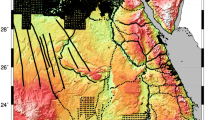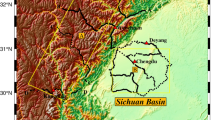Abstract
New generation high resolution gravity models derived from space-borne gravity data, integrated with land based surveys, have enabled understanding of regional gravity field over regions, which are till date considered to be inaccessible for land surveys, especially in mountainous terrains. In this study, we evaluate two high resolution gravity models EIGEN-6C4 and GO_CONS_GCF_2_TIM_R5 in order to understand its usability in identification of meso-scale regional geological features and lithological boundaries around the Karakoram shear zone, in Leh, India. The EIGEN-6C4 is a “hybrid” model integrating data from space-borne sensors and terrestrial data, whereas GO_CONS_GCF_2_TIM_R5 is a model derived from the latest space-borne GOCE sensor. Bouguer gravity anomaly has been derived for both the models and compared. It is seen that, the GOCE derived model pertains to the regional gravity field of the region and compares well with the regional derivative of the EIGEN-6C4 model. Further, the EIGEN-6C4 has been analyzed using horizontal derivatives (dx, dy), analytical signal (ANS) and tilt derivative (TDR) techniques. These, derived maps are then overlain on published geological map of the area to understand the correlation between sub-surface geology vis a vis gravitational signal. The major and distinct geological signatures as derived from the various derivative maps correlate well with the existing geological map. The source boundaries derived from the TDR map agrees reasonably well with the lithological boundaries. Further, the anomaly and derivative maps from EIGEN-6C4 indicates towards a possible continuation of the Shyok suture zone in the region. Therefore, for the given spatial extent of the area under consideration, the GOCE derived model represents the regional field, whereas the EIGEN-6C4 data and derivatives are of sufficient resolution for understanding the geological variability in and around the Karakoram shear zone.
Similar content being viewed by others
References
Agarwal, B.N.P. and Lal, T. (1972a) Calculation of vertical gradient of the gravity field using the fourier transform: Geophys. Prospect.g, v.20, pp.448–458.
Agarwal, B.N.P. and Lal, T. (1969) Calculation of the second vertical derivative of gravity field. Pure Appld. Geophys., v.76 (1), pp.5–16.
Bouman, J., Rispens, S., Gruber, T., Koop, R., Schrama, E., Visser, P., Tscherning, C.C. and Veicherts, M. (2009) Preprocessing of gravity gradients at the GOCE high-level processing facility. Jour. Geodesy, v.83(7), pp.659–678.
Bruinsma, S.L., Lemoine, J.M., Biancale, R. and Vales, N. (2009) CNES/GRGS 10-day gravity field models release 2 and their evaluation. Advances in Space Research. doi:10.1016/j.asr.2009.10.012.
Bruinsma, S.L., Marty, J.C., Balmino, G., Biancale, R., Förste, C., Abrikosov, O. and Neu-mayer, H. (2010) GOCE gravity field recovery by means of the direct numerical method. In: Presented at the ESA Living Planet Symposium, 27th June–2nd July, 2010, Bergen, Norway.
Butler, D.K. (1984b) Microgravimetric and gravity gradient techniques for detentions of subsurface cavities: Geophysics, v.49, pp.1048–1096.
Cooper, G.R.J. and Cowan, D.R. (2004) Filtering using variable order vertical derivatives. Computer and Geosciences, v.30, pp.455–459.
Evjen, H.M. (1936) The place of the vertical gradient in gravitational interpretation. Geophysics, v.1, pp.127–136.
Fajklewicz, Z.J. (1976) Gravity vertical gradient measurements for the detection of small geologic and anthropogenic forms. Geophysics, v.41, pp.1016–1030.
Floberghagen, R., Fehringer, M., Lamarre, D., Muzi, D., Frommknecht, B., Steiger, C, Piñeiro, J. and da Costa, A. (2011) Mission design, operation and exploitation of the gravity field and steady-state ocean circulation explorer mission. Jour. Geodesy, v.85, pp.749–758
Förste et al. (2014) The latest combined global gravity field model including GOCE data up to degree and order 2190 of GFZ Potsdam and GRGS Toulouse. In: 5th GOCE User Workshop, Paris. 25–28 November 2014. url: http://icgem.gfz-potsdam.de/ICGEM/documents/Foerste-et-al-EIGEN-6C4.pdf.
Förste, C., Bruinsma, S., Flechtner, F., Marty, J.C., Dahle, C., Abrykosov, O., Lemoine, J.M., Neumayer, H., Barthelmes, F., Biancale R., and König, R. (2013) EIGEN-6C2—a new combined global gravity field model including GOCE data up todegree and order 1949 of GFZ Potsdam and GRGS Toulouse. In: Geophysical Research Abstracts, V. 15, EGU2013-4077-1, 2013, EGU General Assembly 2013.
Green, R. (1976) Accurate determination of the dip angle of a geologic contact using the gravity method. Geophys. Prospect., v.24, pp.265–272.
Geosoft, (2015) Oasis Montaj software 8.2, Geosoft Inc, Copyright 2008.
Hodges, K.V. (2000) Tectonics of the Himalaya and southern Tibet from two decades perspectives. Geol. Soc. Amer. Bull., v.112, pp.324–350.
Jain, A.K. (2014) When did India–Asia collide and make the Himalaya. Curr. Sci., pp.254–266.
Jain, A.K. and Singh, S. (2008) Tectonics of the southern Asian Plate margin along the Karakoram Shear Zone: Constraints from field observations and U–Pb SHRIMP ages. Tectonophysics, v.451, pp.86–205.
Jain, A.K. and Singh, S. (2009) Geology and Tectonics of southeast Ladakh and Karakoram. Geological Society of India, Bangalore, 179p.
Jain, A.K., Singh, S. and Gupta, K.R. (2007) A Late Cretaceous Karakoram Shear Zone and its reactivation during the Late Cenozoic. IAGR Mem., no.10, pp.77–88.
Jain, A.K., Manickavasagam, R.M. and Singh, S. (2002) Himalayan collision tectonics.Gondwana Res. Group Mem., v.7, pp.114.
Jain, A.K., Singh, S., Manickavasagam, R.M., Joshi, M. and Verma, P.K., 2003. HimprobeProgramme: integrated studies on geology, petrology, geochronology and geophysics of the trans-Himalaya and Karakoram. In: T.M. Mahadevan, B.R., Arora and K.R. Gupta, (Eds.), Indian Continental Lithosphere: Emerging Research Trends. Mem. Geol. Soc. India, no.53, pp.1–56.
Klingele, E.E. Marson, I., and Kahle, H.G. (1991) Automatic interpretation of gravity gradiometric data in two dimensions: vertical gradient. Geophys. Prospect., v.9, pp.407–434.
Majumdar, T.J., Bhattacharyya, R. and Chatterjee, S. (2006) Generation of very high reso-lution gravity image over the Central Indian Ridge and its tectonic implications. Curr. Sci., v.91(5), pp.683–686.
Marson, I. and Klingele, E.E. (1993) Advantages of using the vertical gradient of gravity for 3-D interpretation. Geophysics, v.58(11), pp.1588–1595.
Miller, H.G. and Singh, V. (1994) Potential field tilt—a new concept for location of potential field sources. Jour. Appld. Geophys., v.32, pp.213–217.
Mishra, D.C., Ravi Kumar, M. and Arora, K. (2012) Long wavelength satellite gravity and geoid anomalies over Himalaya, and Tibet: Lithospheric structures and seismotectonics of deep focus earthquakes of Hindu Kush–Pamir and Burmese arc. Jour. Asian Earth Sci., v.48, pp.93–110. doi: 10.1016/j.jseaes.2011.12.003
Mishra, D.C. and Kumar R. (2008) Geodynamics of Indian plate and Tibet: Buoyant lithosphere, rapid drift and channel flow from gravity studies. Five Decades of Geophysics in India. Mem. Geol. Soc. India, no.68, pp.151–172.
Mishra, D.C., Laxman, G. and Arora, K. (2004b) Large wavelength gravity anomalies over the Indian continent: indicator of lithospheric flexure and uplift and subsidence of Indian Peninsular Shield related to isostasy. Curr. Sci., v.84, pp.224–230.
Nabighian, M.N. (1972) The analytic signal of two-dimensional magnetic bodies with polygonal cross-section: its properties and use for automated anomaly interpretation. Geophysics, v.37(3), pp.507–517.
Nabighian, M.N. (1974) Additional comments on the analytic signal of twodimensional magnetic bodies with polygonal cross-section. Geophysics, v.39(1), pp.85–92.
Nabighian, M.N. (1984) Toward a three-dimensional automatic interpretation of potential field data via generalized Hilbert transforms: fundamental relations. Geophysics, v.49(6), pp.780–786.
Oruc, B. and Keskinsezer, A. (2008) Structural setting of the northeastern BigaPenin-sula (Turkey) from tilt derivatives of gravity gradient tensors and magnitude of horizontal gravity components. Pure Appld. Geophys., v.165, pp.1913–1927.
Oruc, B. and Selim, H.H. (2011) Interpretation of magnetic data in the Sinop area of MidBlack Sea, Turkey, using tilt derivative, Euler deconvolution, and discrete wavelet transform. Jour. Appld. Geophys., v.74, pp.194–204.
Pail, R., Bruinsma, S., Migliaccio, F., Förste, C., Goiginger, H., Schuh, W.D., Höck, E., Reguzzoni, M., Brockmann, J.M., Abrikosov, O., Veicherts, M., Fecher, T., Mayrhofer, R., Krasbutter, I., Sansò, F. and Tscherning, C.C. (2011) First GOCE gravity field models derived by three different approaches. Jour. Geodesy, v.85(11), pp.819–843.
Pail, R., Goiginger, H., Schuh, W.D., Hock, E., Brockmann, J.M., Fecher, T., Gruber, T., Mayer-Gurr, T., Kusche, J., Jaggi, A. and Rieser, D. (2010) Combined satellite gravity field model GOCO01S derived from GOCE and GRACE. Geophys. Res. Lett., v.37, L20314.
Pal S.K. and Majumdar T.J. (2015) Geological appraisal over the Singhbhum-Orissa Craton, India using GOCE, EIGEN6-C2 and in situ gravity data. Internat. Jour. Appld. Earth Observation and Geoinformation, v.35, pp.96–119.
Pavlis, N.K., Holmes, S.A., Kenyon, S.C., Factor, J.K. (2008) An Earth Gravitational Model to degree 2160: EGM2008. Presented at the 2008 General Assembly of the European Geosciences Union, Vienna, Austria, April 13–18, 2008.
Rolland, Y., Mahéo, G., Pêcher, A. and Villa, I.M. (2009) Synkinematic emplacement of the Pangong metamorphic and magmatic complex along the Karakorum Fault (N Ladakh). Jour. Asian Earth Sci., v.34, pp.10–25.
Roy, P., Jain A. K. and Singh S. (2010) Microstructures of mylonites along the Karakoram Shear Zone, Tangste Valley, Pangong Mountains, Karakoram. Jour. Geol. Soc. India, v.75(5), pp.679–694.
Roy, P., Jain A.K. and Singh, S. (2016) Kinematic Vorticity Analysis along the Karakoram Shear Zone, Pangong Mountains, Karakoram:Implications for the India-Asia Tectonics. Jour. Geol. Soc. India, v.87(3), pp.249–260
Rummel R., YiW. and Stummer, C. (2011) GOCE gravitational gradiometry. Jour. Geodesy, v.85, pp.777–790.
Salem, A., Williams, S., Fairhead, J.D., Ravat, D.J. and Smith, R., (2007) Tiltdepth method: a simple depth estimation method using first-order magnetic derivatives. Leading Edge, v.26, pp.1502–1505.
Shako, R., Förste, C., Abrikosov, O., Bruinsma, S.L., Marty, J.C., Lemoine, J.M., Flechtner, F., Neumayer, K.H. and Dahle, C. (2014) EIGEN 6C: A High Resolution Global Gravity Combination Model Including GOCE Data. In: F. Flechtner et al., (eds.), Observation of the System Earth from Space–CHAMP, GRACE, GOCE and future missions, Advanced Technologies in Earth Sciences, DOI: 10.1007/978 3 642 32135 1_20, Springer Verlag Berlin Heidelberg 2014
Singh, P., Saikia, A., Pant, N.C. and Verma, P.K. (2013) Insights into the P–T evolution path of Tso Morari eclogites of the north-western Himalayas: Constraints on the geodynamic evolution of the region. Jour. Earth System Sci., v.122(3), pp.677–698.
Stammer, D., Wunsch, C., Giering, R., Eckert, C., Heinbach, P., Marotzke, J., Adcroft, A., Hill, C.N., Marshall, J. (2002) Global ocean circulation during 1992–1997 estimated from ocean observations and a general circulation model. Jour. Geophys. Res., v.107 (C9), pp.3118.
Tapley, B., Ries, J., Bettadpur, S., Chambers, D., Cheng, M., Condi, F. and Poole, S. (2007) The GGM03 Mean Earth Gravity Model from GRACE. EOS Trans. AGU 88 (52), Fall Meeting Supplement, Abstract G42A-03.
Valdiya, K.S. (1984) Evolution of the Himalaya. Tectonophysics, v.105(1), pp.229–248.
Verduzco, B., Fairhead, J.D., Green, C.M. and Mackenzie, C., (2004) New insights into magnetic derivatives for structural mapping. Leading Edge, v.23, pp.116–119.
Yin, A. (2006) Cenozoic tectonic evolution of the Himalayan orogen as constrained by along-strike variation of structural geometry, exhumation history, and foreland sedimentation. Earth Sci. Rev., v.76, pp.1–131.
Author information
Authors and Affiliations
Corresponding author
Rights and permissions
About this article
Cite this article
Roy, P., Sai Krishnaveni, A. & Vinod Kumar, K. Geological evaluation of EIGEN-6C4 and GOCE derived gravity models in and around Karakoram shear zone, Leh, India. J Geol Soc India 90, 51–61 (2017). https://doi.org/10.1007/s12594-017-0663-2
Received:
Revised:
Published:
Issue Date:
DOI: https://doi.org/10.1007/s12594-017-0663-2




